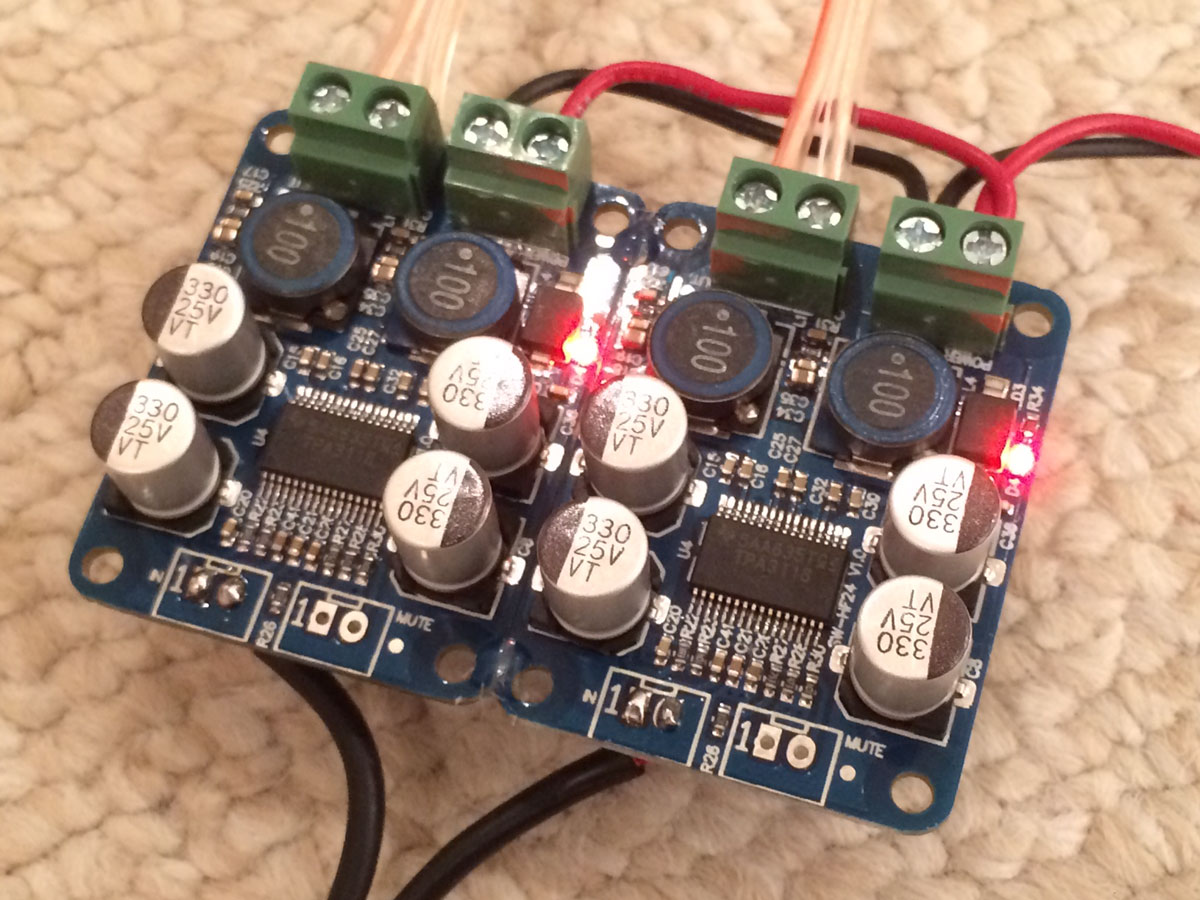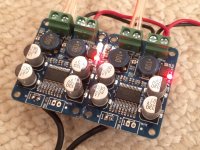Pic of one of the two 32dB boards with the resistors very clear:
Slave 32dB I think, without master that would give 100khz classD amp, chinese 2.1 specialty because TI refuges to update datasheet
Sanwu 3118 stereo completed
I just wired it up with my iPhone as the source, a 19v 4.5A SMPS brick and my XL-S speakers. Still using the stock 36dB gain to hear what it sounds like before taking the resistor off.
It sounds fantastic with the phone - just the right level of gain to be able to get loud with phone headphone outputs. This is a really nice amp, clear sparkling treble, deep bass. No turn on or off thump, and even at 36dB with 90dB sensitive speakers - no hiss from tweeter unless my ear is 1in away. Just really amazed at the sound quality. I can't believe it is a bone-stock $8/ch amp.

I just wired it up with my iPhone as the source, a 19v 4.5A SMPS brick and my XL-S speakers. Still using the stock 36dB gain to hear what it sounds like before taking the resistor off.
It sounds fantastic with the phone - just the right level of gain to be able to get loud with phone headphone outputs. This is a really nice amp, clear sparkling treble, deep bass. No turn on or off thump, and even at 36dB with 90dB sensitive speakers - no hiss from tweeter unless my ear is 1in away. Just really amazed at the sound quality. I can't believe it is a bone-stock $8/ch amp.

Attachments
TPA3118D2
And all that without bootstrap snubbers, ceramics in output filter and no-spec bulk caps..
So what's the main difference to the earlier boards except a tighter layout.
FYI
If the data is correct:
http://mxcapacitor.buy.splicd.com/pz69cdc55-vt-6-3v-22uf-smd-electrolytic-capacitor.html
The caps are made for 450mA ripple.
And all that without bootstrap snubbers, ceramics in output filter and no-spec bulk caps..
So what's the main difference to the earlier boards except a tighter layout.
FYI
If the data is correct:
http://mxcapacitor.buy.splicd.com/pz69cdc55-vt-6-3v-22uf-smd-electrolytic-capacitor.html
The caps are made for 450mA ripple.
Last edited:
gnd is different because it is small, chipgnd, source gnd and power gnd, less distance is less voltage difference for highfrequency currents, still could be improved
Bootstrap snubbers can be added and one could fit Wurth inductors and replace the bulk for something low-esr like polymer/solid electrolytics
Bootstrap snubbers can be added and one could fit Wurth inductors and replace the bulk for something low-esr like polymer/solid electrolytics
Bootstrap snubbers can be added
What will be improved if
beside EMI? This answer got never answered here within the thread (to my knowledge). What sound/audio detail gets imnproved by doing so?This is a really nice amp, clear sparkling treble, deep bass.
I need to make an amplifier distortion measurment rig. I am curious if my ears are telling me that these new Sanwu's have some magical quality to them. They are first and foremost transparent - nothing exaggerated but I need to measure. Speakers have -50dB HD limit (ScanSpeak 10F/8424 from 400Hz and up). So far tested them on several other speakers and can already hear that they sound cleaner.
If I have a dummy resistor load - is it as simple as making a voltage divider to ensure that signal received by RCA inputs of sound interface is less than 2v? Simply do a sweep of signal with soundcard output fed to amp (calibrate level with Fluke DMM) and measure HD components and frequency response of voltage at dummy load (5ohm or 8ohm power resistor).
I plan to use REW software and Behringer UCA202 interface. UCA202 has already been characterized as low HD by NWAvGuy. I will also measure it myself with loop back.
NwAvGuy: Behringer UCA202 Review
Then let's quantify why this 3118 PBTL board sounds so good.
My ears have been tested to detect distortion as low as -45dB with the Klippel on line test so I am sensitive to distortion and low distortion is one of the things I listen for when I say something sounds good.
Listening Test
If I have a dummy resistor load - is it as simple as making a voltage divider to ensure that signal received by RCA inputs of sound interface is less than 2v? Simply do a sweep of signal with soundcard output fed to amp (calibrate level with Fluke DMM) and measure HD components and frequency response of voltage at dummy load (5ohm or 8ohm power resistor).
I plan to use REW software and Behringer UCA202 interface. UCA202 has already been characterized as low HD by NWAvGuy. I will also measure it myself with loop back.
NwAvGuy: Behringer UCA202 Review
Then let's quantify why this 3118 PBTL board sounds so good.
My ears have been tested to detect distortion as low as -45dB with the Klippel on line test so I am sensitive to distortion and low distortion is one of the things I listen for when I say something sounds good.
Listening Test
Last edited:
What will be improved if (quote irribeo:bootstrapsnubbers can be added)
(quote xrk I guess: This is a really nice amp, clear sparkling treble, deep bass.
beside EMI? This answer got never answered here within the thread (to my knowledge). What sound/audio detail gets imnproved by doing so?
I don't think EMI will be intentionally improved. ST engineers say it like this:
"When the output of a Class-D amplifier switches there normally is a "dead" time between the time when one transistor is turned off and the other transistor is turned on. The dead time is necessary to insure that both transistors are never conducting at the same time, which would cause large currents to flow from the power supply to ground through the transistors. However, the dead time causes a problem because it interrupts the current flowing through the inductors. Snubbers are normally used on the amplifier outputs to provide another path for the inductor current during the dead time.
Common-mode snubbers for amplifiers with BTL outputs use twice as many parts as a differential snubber but they may reduce harmonic distortion. The type of snubber to use will depend on the application. The amplifier manufacturer will normally recommend values for the snubber components."
Has anyone tried installing 180uf 25v oscons?
They would fit and are the highest value 25v which are 8mm squared. I would like to try fitting them however fitting €7 of caps to a €6 euro board seems a bit odd.
I´ve done stranger things.
Doctormord posted a link to capacitors that are on the ampboards, if information in that datasheet is correct the original electrolytics are not 8mm but 10mmx10.5mm, so you could use 330uF Oscon if you like
If the data is correct:
VT 6.3V 22uF SMD Electrolytic Capacitor - mxcapacitor
The caps are made for 450mA ripple.
According to the above web site, 330uF/25V caps should have 10mm diameter & 10.5mm height
On my boards, 330uF/25V caps are 10.5mm high, but 8mm diameter. Doing a quick Google, didn't find any 330uF/25V SMD caps with a diameter of 8mm
j.R.c
Doctormord posted a link to capacitors that are on the ampboards, if information in that datasheet is correct the original electrolytics are not 8mm but 10mmx10.5mm, so you could use 330uF Oscon if you like
I have a couple of 330uF/25V oscons in stock, so had a look ... with sufficient care oscons could be fitted, or any radial cap with 10mm diameter, for that matter
j.R.c
Are you guys suggesting that we remove the four stock 330uF 25V caps and replace with two 330uF 25V SEPF OSCON's? I don't think there is enough room for four 330uF SEPF's as they are larger in diameter. I don't have the board in front of me, but those stock caps appear smaller than the 330uF SEPF's.
One thing I like about this board is the fact that it is stock and sounds so good already. Spending $1.80ea for the SEPF's really drives the price up. But from a modding standpoint I suppose that is chump change.
Edit, actually for SMT, the cap is the SVPF series 10.3mm base.
http://www.mouser.com/ds/2/315/SVPF_OS-262415.pdf

One thing I like about this board is the fact that it is stock and sounds so good already. Spending $1.80ea for the SEPF's really drives the price up. But from a modding standpoint I suppose that is chump change.
Edit, actually for SMT, the cap is the SVPF series 10.3mm base.
http://www.mouser.com/ds/2/315/SVPF_OS-262415.pdf

Last edited:
The caps are made from:
Huasing Electronics Co, ltd.
Websites:
Huasing Electronics Capacitors Manufacturer Suppli
and
Huasing Electrolytic Capacitor Manufacturer
Both websites doesn't show any data for the "VT" line caps.
Only caps shown are:
Huasing Electrolytic Capacitor Manufacturer
So, hmm...
Here's the rest of all this "legit proof pics".
http://mxcapacitor.sell.nccecojustice.org/c1370379-smd-electrolytic-capacitor
Huasing Electronics Co, ltd.
Websites:
Huasing Electronics Capacitors Manufacturer Suppli
and
Huasing Electrolytic Capacitor Manufacturer
Both websites doesn't show any data for the "VT" line caps.
Only caps shown are:
Huasing Electrolytic Capacitor Manufacturer
So, hmm...
Here's the rest of all this "legit proof pics".
http://mxcapacitor.sell.nccecojustice.org/c1370379-smd-electrolytic-capacitor
Last edited:
- Home
- Amplifiers
- Class D
- Cheap TPA3118D2 boards, modding them and everything that comes with it
